| View previous topic :: View next topic |
| Author |
Message |
Aymeric
Joined: 20 Feb 2009
Posts: 32
Location: Between France & Pakistan


|
 Posted: Feb 20, 2009 17:19 Post subject: Re: Endomorph or Pseudomorph? Posted: Feb 20, 2009 17:19 Post subject: Re: Endomorph or Pseudomorph? |
|
|
| Excellent reading, thank you very much Mark ! I'm regularly confronted to what I used to call pseudomorphs, and know I see them under a new light ! aaaaah, the pleasure of learning !
|
|
| Back to top |
|
 |
Pete Richards
Site Admin
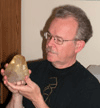
Joined: 29 Dec 2008
Posts: 843
Location: Northeast Ohio



|
 Posted: Feb 20, 2009 19:27 Post subject: Re: Endomorph or Pseudomorph? Posted: Feb 20, 2009 19:27 Post subject: Re: Endomorph or Pseudomorph? |
|
|
I agree with Mark that the use of pseudomorph as a general term is useful. I had never heard of endomorph before, and to my thinking it does not make any sense. If the original mineral is inside (endo) it has not morphed! I could see using the term endomorph for a cast as Mark defines it, but I think the number of situations where it could be applied unambiguously is pretty small. You would have to determine that an epimorph was cast with a new mineral and dissolved away leaving an "endomorph" in this sense, AND that this was the process instead of simple replacement pseudomorphy. Not likely.
Incidentally, the terms mold and cast are in common usage in paleontology. The mold is what is left when the fossil dissolves away and the matrix retains the shape, and a cast is what results when the hollow space is filled in with another mineral.
An interesting cross-discipline experiment: take a nice brachiopod fossil and immerse it in a concentrated solution of copper sulfate. After a week or so, you'll have a brachiopod made at least in part of malachite - a pseudomorph of malachite after brachiopod!
_________________
Collecting and studying crystals with interesting habits, twinning, and epitaxy |
|
| Back to top |
|
 |
Peter Megaw
Site Admin

Joined: 13 Jan 2007
Posts: 973
Location: Tucson, Arizona



|
 Posted: Jan 26, 2010 13:55 Post subject: Re: Endomorph or Pseudomorph? Posted: Jan 26, 2010 13:55 Post subject: Re: Endomorph or Pseudomorph? |
|
|
Here is a beautiful example of development of an epimorph/encrustation pseudomorph from the famous "crazy lace" agate locality in Chihuahua. We have an exploration project called "Cinco de Mayo" surrounding the locale...and it appears genetically related to the Au-Ag-Pb-Zn-Cu-Mo mineralization we're chasing, so we've had rare justification for paying close attention to it. I have always been fascinated by the patterns in crazy lace...sharp rectilinear banding mixed with wild arcuate banding...but frustrated by only having standard 30 x 40 oval cabochon samples to study.
In examining outcrops of the agate it became apparent that the agate filled voids in a limestone breccia developed along a complex thrust fault. The breccia clearly ruptured repeatedly and voids were alternately filled with fine-grained laminated sediments (cave fill) and scalenohedral calcite with silicification occurring repeatedly. The patterns of the "ghosts" of the scalenohedral calcites suggested fillings remarkably similar to the "diente de perro" (dog-tooth) calcite that cements limestone breccias at Santa Eulalia, which helped in understanding what is going on. It was easy to find hand-samples of silicified cave fill showing beautiful cross-bedding, the difficulty was to get a manageable size piece that showed the dog-teeth unequivocally. I finally succeeded recently in getting couple of slabs of just such a piece and am delighted with the results Here are three increasing close-up scans that show what happened and demonstrate how this epimorph developed.
It clearly looks like scalenohedral calcite was first coated with something...now silica, and then the body of the crystal dissolved away leaving "voids" above and below the "crust" into which beautifully banded chalcedony could grow In essence an "endomorph" that lost its "morph" leaving just a delicate "endo". (Being an ex-physical anthropologist ectomorph en route to becoming a mesomorph, I think this term should be abandoned in favor of epimorph...but I am not trying to stir the semantic pot here).
Note that the growth bands work both ways off the coating, suggesting that it was somehow supported...probably in silica gel. If you look very closely you can see that there were crystallites of something elongate...and silica tubules as well...that also grew in both directions off the crust. These appear to have had more 'elbow-room" to grow off the original free faces of the calcite however suggesting that things were more liquid in that direction. Notably the banding is not symmetrical with respect to the crust, perhaps indicating it remained a barrier to gel or fluid movement across the void. It also looks like the red iron-oxide coloring was introduced late along the "veinlet" that cuts across the banding.
Looking at more chaotic banding iin many crazy lace agates I suspect that in many cases the crust collapsed and formed piles of shards that then got overgrown by the agate stage...and cutting through these at various angles gives the wild patterns the material is famous for.
Happy to hear agate and pseudomorph experts weigh in on this!!!
| Description: |
| Crazy lace agate slab about 16 cm across |
|
| Viewed: |
42389 Time(s) |
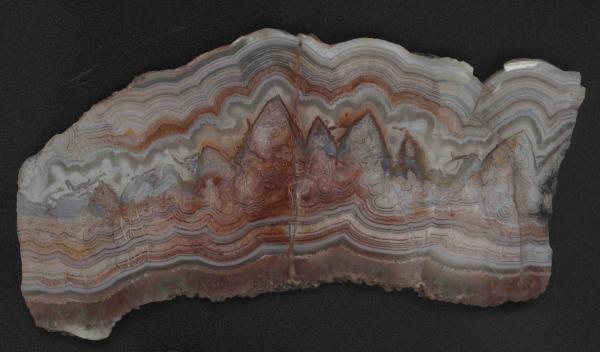
|
| Description: |
| Close-up view of crazy lace agate...field of view about 6 cm |
|
| Viewed: |
42371 Time(s) |
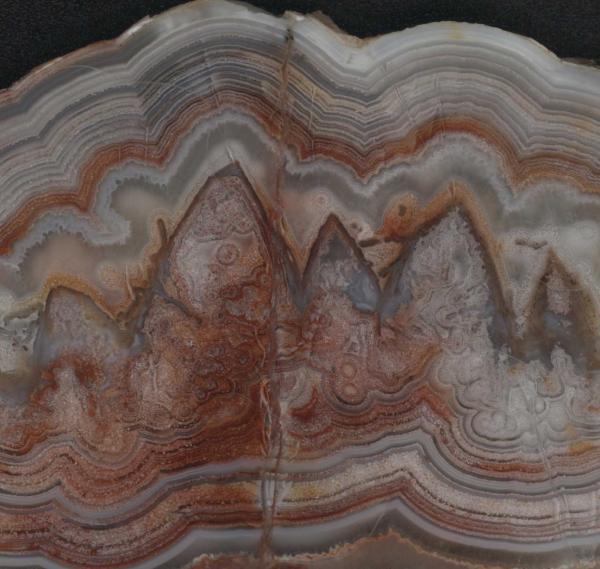
|
| Description: |
| Closest-up view of crazy lace agate...field of view about 4 cm |
|
| Viewed: |
42370 Time(s) |
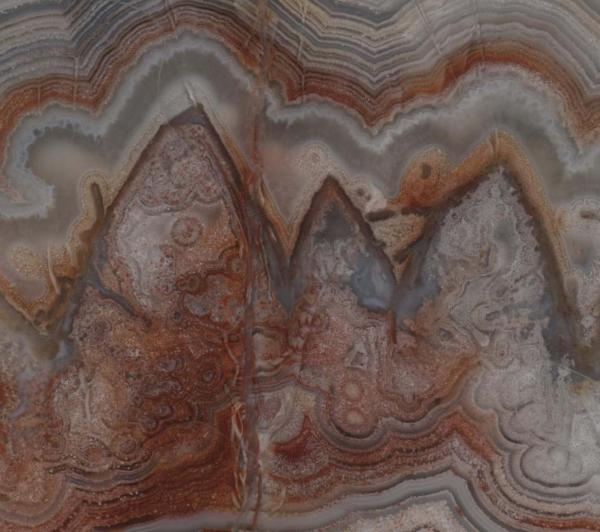
|
_________________
Siempre Adelante! |
|
| Back to top |
|
 |
Tomasz Praszkier
Joined: 20 Dec 2009
Posts: 93
Location: Warszawa



|
 Posted: Jan 26, 2010 14:46 Post subject: Re: Endomorph or Pseudomorph? Posted: Jan 26, 2010 14:46 Post subject: Re: Endomorph or Pseudomorph? |
|
|
Mark,
My English is poor but... Did I well understood that in your opinion perimorphose=epimorphose?? For this kind of coatings with dissoluted primary mineral I always used term perimorphose.
Tom
_________________
Tomek |
|
| Back to top |
|
 |
Pete Richards
Site Admin

Joined: 29 Dec 2008
Posts: 843
Location: Northeast Ohio



|
 Posted: Jan 26, 2010 18:18 Post subject: Re: Endomorph or Pseudomorph? Posted: Jan 26, 2010 18:18 Post subject: Re: Endomorph or Pseudomorph? |
|
|
Peter,
Certainly these are very interesting images. Could you please put the specimen through a tomograph and show us the slices perpendicular to this viewing direction? That would be very helpful in deciding whether the original mineral was calcite. But it might require a four-dimensional tomograph with retroactive capability, and not many labs have that....
Cheers
_________________
Collecting and studying crystals with interesting habits, twinning, and epitaxy |
|
| Back to top |
|
 |
Peter Megaw
Site Admin

Joined: 13 Jan 2007
Posts: 973
Location: Tucson, Arizona



|
 Posted: Jan 26, 2010 18:29 Post subject: Re: Endomorph or Pseudomorph? Posted: Jan 26, 2010 18:29 Post subject: Re: Endomorph or Pseudomorph? |
|
|
Pete, tongue-in-cheek aside, the surface outcrops of these do give a 3D view and they are symmetrical with respect to the axis of elongation...but I suspect you would only be convinced of calcite if I ran it through a dual-channel reframitizer with proactive processing and at the moment that senstive piece of equipment has burned out another filament...
_________________
Siempre Adelante! |
|
| Back to top |
|
 |
Antonio Da Silveira

Joined: 11 Oct 2007
Posts: 25
Location: Artigas


|
 Posted: Jan 26, 2010 18:59 Post subject: Re: Endomorph or Pseudomorph? Posted: Jan 26, 2010 18:59 Post subject: Re: Endomorph or Pseudomorph? |
|
|
Amethyst Pseudomorph, Artigas Uruguay.
Antonio
| Description: |
Amethyst Pseudomorph tall 28 cm
"Santiño Mine" |
|
| Viewed: |
42318 Time(s) |
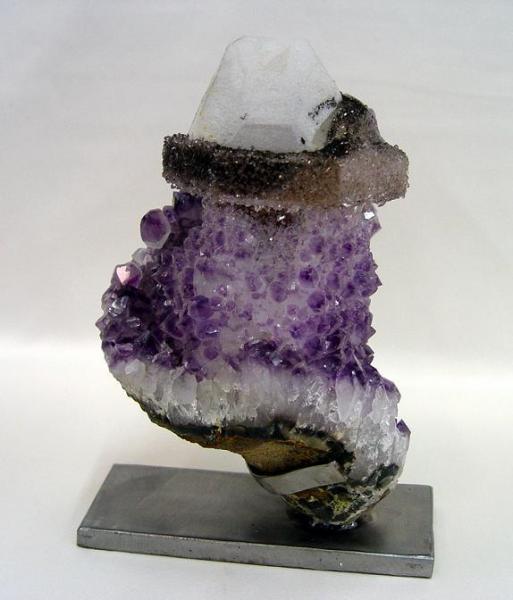
|
| Description: |
| Amethyst Santiño Mine, Uruguay |
|
| Viewed: |
42379 Time(s) |
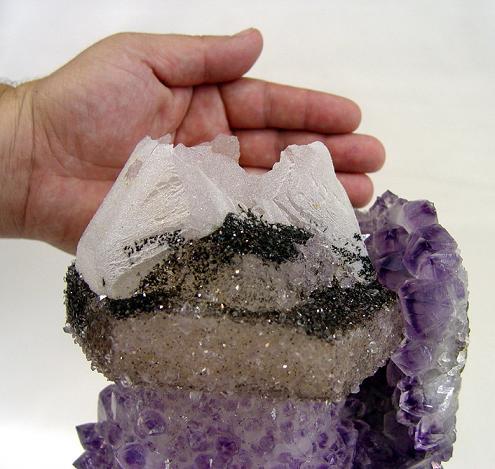
|
| Description: |
|
| Viewed: |
42327 Time(s) |
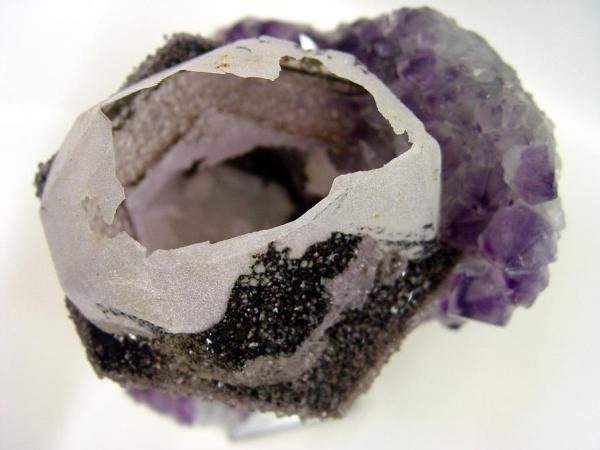
|
|
|
| Back to top |
|
 |
Jordi Fabre
Overall coordinator of the Forum

Joined: 07 Aug 2006
Posts: 5026
Location: Barcelona



|
|
| Back to top |
|
 |
John S. White
Site Admin

Joined: 04 Sep 2006
Posts: 1298
Location: Stewartstown, Pennsylvania, USA



|
 Posted: Jan 27, 2010 05:49 Post subject: Re: Endomorph or Pseudomorph? Posted: Jan 27, 2010 05:49 Post subject: Re: Endomorph or Pseudomorph? |
|
|
Antonio:
I have seen several very similar specimens recently from Artigas. They are magnificent and they defy understanding. Talk about multi-stage paragenesis, there must have been at least a half-dozen events in the development of this amazing specimen.
_________________
John S. White
aka Rondinaire |
|
| Back to top |
|
 |
John S. White
Site Admin

Joined: 04 Sep 2006
Posts: 1298
Location: Stewartstown, Pennsylvania, USA



|
 Posted: Jan 27, 2010 05:54 Post subject: Re: Endomorph or Pseudomorph? Posted: Jan 27, 2010 05:54 Post subject: Re: Endomorph or Pseudomorph? |
|
|
Peter, why are you still working with that obselete hardware? It is about time that you upgraded to newer technologies. (I really dislike technologies instead of technology, but it is very much in fashion these days and I use it here only because it seems to fit the sense of this thread.)
_________________
John S. White
aka Rondinaire |
|
| Back to top |
|
 |
Peter Megaw
Site Admin

Joined: 13 Jan 2007
Posts: 973
Location: Tucson, Arizona



|
 Posted: Jan 27, 2010 23:00 Post subject: Re: Endomorph or Pseudomorph? Posted: Jan 27, 2010 23:00 Post subject: Re: Endomorph or Pseudomorph? |
|
|
John...never thought I'd live to hear you admit to being a slave of fashion! I love it!
_________________
Siempre Adelante! |
|
| Back to top |
|
 |
Peter Megaw
Site Admin

Joined: 13 Jan 2007
Posts: 973
Location: Tucson, Arizona



|
 Posted: Feb 20, 2010 19:47 Post subject: Re: Endomorph or Pseudomorph? Posted: Feb 20, 2010 19:47 Post subject: Re: Endomorph or Pseudomorph? |
|
|
Here's a puzzler I picked up at Tucson last week that plays to some recent discussions we've had regarding various mechanisms of pseudomorphing. This material has been around in many forms from Guanajuato for years...but generally as hollow shells of dolomite with the shape of precursor calcite that is gone. This one is different in that calcite is still there in the center with perfectly mirror smooth faces...and there is a void between the calcite and the dolomite shell. The interior-looking surface of the dolomite is crystallized, but not smooth, and tiny pyrites grew on both the smooth calcite faces and the interior dolomite face. Did the calcite grow inside the shell after an earlier calcite stage that was directly coated by dolomite was dissolved? or was the calcite covered with something that got covered by dolomite and was itself then dissolved. This would make the dolomite an epimorph after something other than calcite that itself took the shape of the calcite but is now gone. The pyrites add another dimension, they are clearly younger than both the calcite and dolomite shell, but did they grow in the void after the absent mystery phase got dissolved, or did they grow in it? It has been suggested that ephemeral phases of halite or gypsum/anhydrite...or even gels can grow between epithermal mineralization stages and later get removed leaving no trace.
Any thoughts of other possibilities, or other phases that might form and disappear into solutions that damage neither calcite nor dolomite?
| Description: |
| dolomite over calcite "epimorph" from Guanajuato, Mexico. Minature |
|
| Viewed: |
99718 Time(s) |
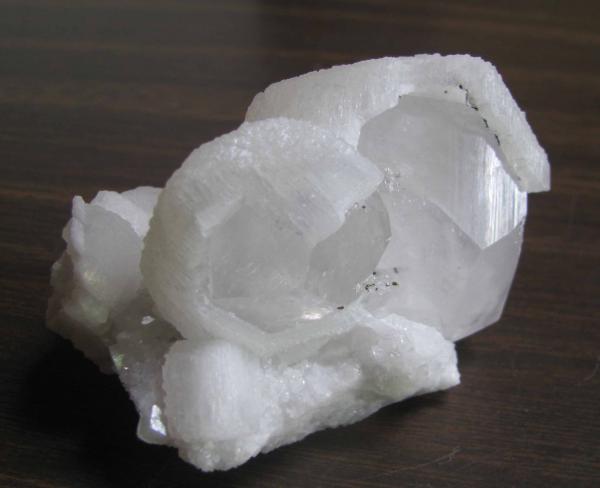
|
| Description: |
| close up showing void between dolomite overgrowth and smooth calcite foundation crystal |
|
| Viewed: |
99745 Time(s) |
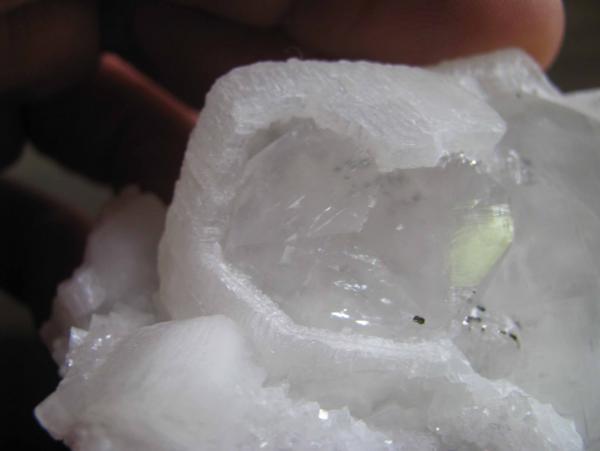
|
| Description: |
| close up of pyrite crystals on smooth calcite crystal face in void under dolomite |
|
| Viewed: |
99708 Time(s) |
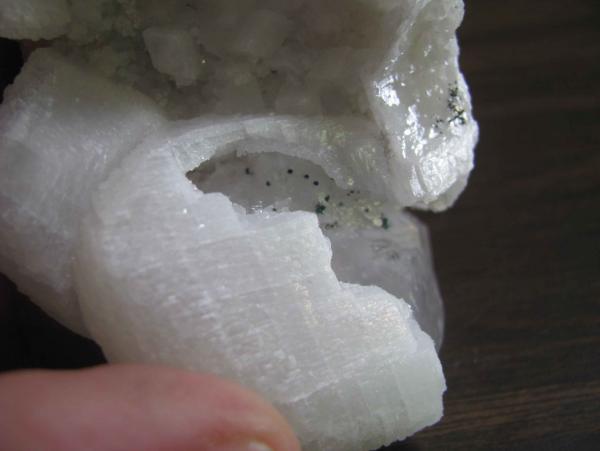
|
_________________
Siempre Adelante! |
|
| Back to top |
|
 |
dtkasper
Joined: 27 Dec 2010
Posts: 13
Location: Lancaster


|
 Posted: Dec 27, 2010 04:17 Post subject: Re: Endomorph or Pseudomorph? Posted: Dec 27, 2010 04:17 Post subject: Re: Endomorph or Pseudomorph? |
|
|
Neither.
The main band looks like a hash of zeolite, perhaps natrolite. They make the short rods with rounded tips. Then calcite formed on top of the hash. It encased most of the natrolite, but not all. Then silica intruded. The pink may, in fact, be from other related zeolites such as heulandite. Silica as chalcedony and agate has a strong propensity to precipitate in carbonate systems. In this case the silica precipitated in a limestone body. It is a vein deposit, so deposition was occurring inward from both sides at the same time. The center with the zeolites and calcite was the last open space before the final silica intrusion. The one-sided nature of the crystallization shows that this vein was probably far from vertical and the crystals are a geopetal indicating the original bottom of the formation. Vertical veins would be expected to have the mineralization pointed to the center from both sides, top and bottom of your specimen in this case.
|
|
| Back to top |
|
 |
dtkasper
Joined: 27 Dec 2010
Posts: 13
Location: Lancaster


|
 Posted: Dec 27, 2010 04:33 Post subject: Re: Endomorph or Pseudomorph? Posted: Dec 27, 2010 04:33 Post subject: Re: Endomorph or Pseudomorph? |
|
|
Neither.
The solution had two phases. The dolomite formed first and the calcite was entrapped second. The pyrite created some acidity leading to the dissolution of the calcite.
An equivalent with amygdules is found all the time. The amygdules are silica found with calcite rhombs in them and the only explanation people propose is meteoric waters intruding with calcite afterward. Of course, their are molds of calcite crystals on the outsides and insides of amygdules all the time. I say it came from one colloid and the crystallization favors silica precipitation first. The water is pushed up and out with the calcite. You get a blister on top commonly with calcite or druzy quartz.
Extrapolations across geologic systems has to be done carefully, but I see the common equivalence of silica and calcite all the time. Calcite forms at the very first and at the very end, two times and for different reasons (first insolubility at high temp, second degassing of CO2 at low temp) so the sequence of formation is always complex to unravel.
|
|
| Back to top |
|
 |
Jordi Fabre
Overall coordinator of the Forum

Joined: 07 Aug 2006
Posts: 5026
Location: Barcelona



|
|
| Back to top |
|
 |
|





